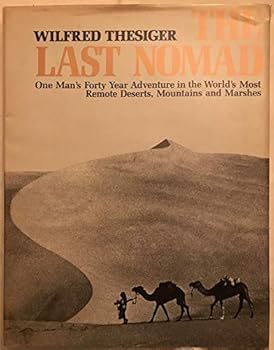The Last Nomad
Select Format
Select Condition 
Book Overview
No Synopsis Available.
Format:Hardcover
Language:English
ISBN:0525930779
ISBN13:9780525930778
Release Date:March 1980
Publisher:Dutton Books
Length:304 Pages
Weight:2.90 lbs.
Related Subjects
Biographical Biographies Biographies & History Biography & History History Middle East Travel WorldCustomer Reviews
1 rating
FORGET ARABIAN SANDS, this is the book you want!
Published by Thriftbooks.com User , 16 years ago
While waiting for my inter-library loan of Arabian Sands to show up I pulled this, The Last Nomad, off my librarys shelf. Turns out they are the same book! Same tho only in text. The Last Nomad is a big 20" x 20" book filled with big beautiful black and white photos Some full page and a few even two page spreads. Tho they do suffer from being black and white imho, Wilfred Thesiger is an excellent photographer. The "portraits" of the people are wonderful. This is the book to get. FORGET ARABIAN SANDS. Arabian Sands is a small 7.8 x 5.1 book with small pictures. And not all the pictures to boot. My favorite part was the Iraq Marshes (1950-'58). The stunning "buildings" the Marsh Arabs made solely from the TWENTY foot tall reeds that grew there. WOW. This is the area where the rivers Tigris and Euphrates join, and is thought by some to be the original site of the Garden of Eden. "The 5,000-year-old way of life of the Marsh Arabs, celebrated by Wilfred Thesiger among others, has long been under threat. Its final disappearance is documented in The Iraqi Marshlands edited by Emma Nicholson and Peter Clark. Saddam Hussein's aggressive drainage programme in the 1990s, in pursute of rebels hiding in the waterways, turned much of the marshland into desert, depopulating the area. Some 200,000 of the inhabitants fled, many of them to refugee camps in Iran. The damage is probably irretrievable." Dams in Turkey, Syria and Iran have further reduce the amount of water flowing down the Tigris and Euphrates. All the bird and wildlife is lost. Latest satellite images show that less than 7% of the Mesopotamian marshes now remain intact. What confuses me is the contrast between the various "modern" tribes and the stunningly huge, beautiful and complex brick buildings built thousands of years ago by their ancestors. I can't seem to connect the two. What happened to them? How is it possible to regress so?




